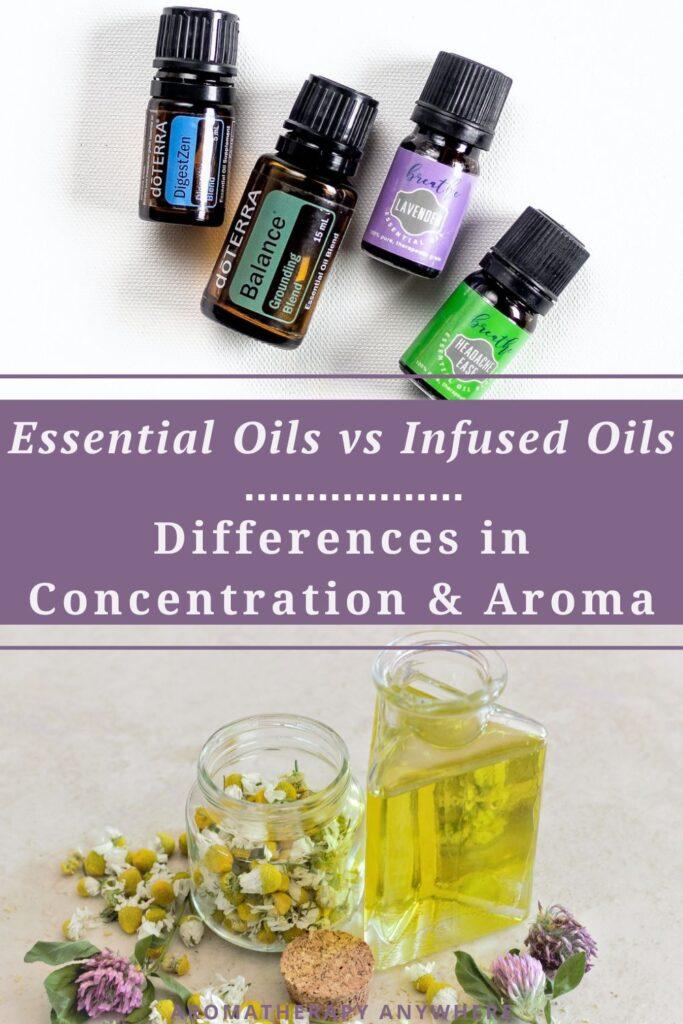As an Amazon Associate I earn from qualifying purchases. See Full Disclosure Here
Infused oils and essential oils are both aromatic oils produced from various plant plants. When it comes to infused oils vs essential oils, the similarities end there.
 Both oils offer significant benefits and both are hugely popular in a wide range of applications. However, they differ in almost all aspects, from their extraction methods to their properties, benefits, and applications.
Both oils offer significant benefits and both are hugely popular in a wide range of applications. However, they differ in almost all aspects, from their extraction methods to their properties, benefits, and applications.
Before diving into a detailed comparison of infused oils vs essential oils, it helps to understand the characteristics of each oil.
What Are Infused Oils?
Infused oils or herb-infused oils are created by steeping whole plant material into a carrier oil such as coconut, jojoba, or evening primrose oil
The plant material used varies depending on the plant in question. For example, lavender infused oil is created with lavender flowers. Same with rose infused oil – created with fresh or dried rose petals. But rosemary infused oil is created with the leaves of the rosemary plant.
Steeping the plant material in the oil allows the oil to absorb the beneficial compounds from the plants, making it an excellent medium for extracting its medicinal properties.
Making infused oils requires patience and time, as the oils need to infuse for several weeks to ensure maximum potency.
Herbal-infused oils are versatile and can be used on their own or serve as a foundation for various skincare products like creams, lotions, and lip balms. They as a carrier for herbal constituents, allowing them to penetrate deeper into the body.
One of the most notable advantages of herb-infused oils are that they are safe to use in larger amounts without the risk of sensitization or adverse reactions.
When it comes to skincare, infused oils offer a gentle and effective way to cleanse the skin. Unlike traditional soap and water, these oils work by binding to the natural oils (sebum) produced by the skin and drawing out impurities. This method, known as the Oil Cleansing Method, is particularly beneficial for facial skincare.
What are Essential Oils?
Essential oils are highly concentrated plant extracts obtained either through steam distillation or cold pressing. These methods capture only the volatile compounds of aromatic plants, resulting in potent oils that carry the distinct fragrance and therapeutic properties of the source plant.
The water that’s collected during the extraction process is known as hydrosol or flower water.
Essential oils are known for their powerful scents and are often used in aromatherapy. They can also be used in body care formulations to support various skin issues.
Compared to dried herbs, essential oils are significantly stronger, with an average potency that is several times higher. Because of this higher potency essential oils must be used sparingly and handled carefully.
Before applying any essential oil to the skin, it must be diluted in a carrier oil in the recommended dilution to avoid skin rash or irritation. It’s equally important to perform a patch test when using essential oils for the first time to ensure that your skin is not sensitive to that particular oil.
While essential oils offer many benefits, their concentrated nature can be overwhelming for some individuals.
A Closer Comparison Of The Differences Between Infused Oils & Essential Oils
With a better understanding of what are infused oils and what are essential oils, here’s a more detailed breakdown of infused oils vs. essential oils in terms of their production process, safety, effectiveness, and traditional use.
Infused Oils vs. Essential Oils: Production Process
 Infused oils are created by steeping dried or fresh herbs, flowers, or other plant parts with carrier oil, such as olive, coconut, or jojoba oil. The mixture is allowed to infuse for a period of time, after which the plant material is strained out.
Infused oils are created by steeping dried or fresh herbs, flowers, or other plant parts with carrier oil, such as olive, coconut, or jojoba oil. The mixture is allowed to infuse for a period of time, after which the plant material is strained out.
This method allows the beneficial compounds from the plants to saturate the oil fully. The process is slow and gentle, as the oils need to infuse for several weeks for maximum potency.
In contrast, essential oils are obtained through distillation, which involves heating the plant material to extract the volatile compounds.
Essential oils are typically derived from flowers, leaves, stems, bark, roots, or other plant parts through steam distillation. This involves passing steam through the plant material, causing the essential oil to evaporate. The vaporized essential oil is then condensed and collected.
Citrus essential oils are the exception in that they are extracted through a cold compress technique. Citrus oils are obtained only from the peel of the citrus fruit.
Steam distillation of essential oils is an intensive process that must be carried out under precise conditions.
Infused Oils vs. Essential Oils: Concentration Of The Extract
Essential oils are highly concentrated and must be used sparingly. A little goes a long way. For topical applications, they must be diluted with a carrier oil.
Infused oils are mild and gentle enough to be applied to the skin directly. When applied topically, you get the benefits of the carrier oil as well as the plant extract.
Infused Oils vs. Essential Oils: Aroma Of The Extract
 Infused oils carry a more subtle scent compared to essential oils, as their aromatic compounds are not as concentrated. They primarily retain the properties of the infused plant material, offering a milder and more nourishing effect on the skin.
Infused oils carry a more subtle scent compared to essential oils, as their aromatic compounds are not as concentrated. They primarily retain the properties of the infused plant material, offering a milder and more nourishing effect on the skin.
Essential oils are highly concentrated, requiring a large amount of plant material to produce a small quantity of oil. This concentration amplifies their aroma and therapeutic benefits.
Infused Oils vs. Essential Oils: Skincare and Topical Application
Infused oils are popular in skincare routines due to their moisturizing, soothing, and healing properties. They can be used directly on the skin, providing hydration, and nourishment, and promoting a healthy complexion. They also act as carriers for herbal constituents, allowing them to penetrate deeper into the body.
Essential oils, on the other hand, are known for their powerful scents and therapeutic properties. They can be used in aromatherapy to promote relaxation, uplift the mood, or address specific health concerns. When properly diluted, essential oils can also be used in body care formulations to support skin health.
Infused Oils vs. Essential Oils: Aromatherapy and Emotional Well-being
Infused oils have limited aromatherapy applications. They cannot be added to a diffuser and inhaling the scent doesn’t enhance emotional well-being.
Essential oils are commonly used in aromatherapy to promote relaxation, uplift mood, relieve stress, and improve overall emotional well-being. The inhalation of their fragrance stimulates the limbic system, which is associated with emotions, memory, and behavior.
differences in packaging
Infused oils are generally packaged in larger bottles as they are meant to be applied generously over the skin. They may be stored in either dark or clear glass bottles.
Essential oils are packaged in smaller bottles as they are meant to be used very sparingly – just a few drops at a time. They must always be packaged in dark glass bottles, as they can be easily damaged by overexposure to sunlight.
Safety Considerations
Infused oils are generally safe for direct application to the skin, making them more user-friendly and suitable for individuals with sensitive skin or those seeking a milder approach to natural remedies.
Essential oils, however, are highly concentrated and must be used with caution. They should be diluted in a carrier oil before application and should not be used on babies or during pregnancy for an extended period.
Popular Infused Oils And Essential Oils
5 Popular infused oils include:
1. Calendula
2. Comfrey
3. Marshmallow Root
4. Rose
5. St. John’s Wort
5 Popular essential oils include:
1. Lavender
2. Peppermint
3. Lemon
4. Rosemary
5. Eucalyptus
What’s interesting is that some plant parts can be used to extract essential oils and also to make infused oils. For example, you can find lavender, rose, and rosemary in both varieties.
However, some plants can be used only for one or the other. For example, calendula, comfrey, and marshmallow root can be used to make infused oils but you cannot extract essential oils from these plants.
Can You Make Infused Oils And Essential Oils At Home?
You can make infused oils at home but you cannot make essential oils at home.
Well, technically you can make essential oils at home if you have the steam distillation equipment. But unless you know the ideal conditions for making essential oils, you shouldn’t attempt it at home.
In commercial manufacturing plants, essential oils are extracted under carefully controlled and precise conditions with regard to temperature and processing time. Also, the place is clean and sanitized to prevent any accidental contamination.
Last but not least, essential oils undergo stringent quality control to ensure that they are perfect in every way before bottling. All of these measures ensure that the oils are pure. contaminant-free, and will last a long time. It can be challenging to replicate these conditions at home.
Infused oils don’t require such a high degree of precision and can be made at home easily.
How to Make Calendula Oil+ Uses & Benefits
How to Make Rose Infused Oil+ Uses & Benefits
Infused Oils Vs Essential Oils – Which One Is Right For You?
 Both essential oils and infused oils offer distinct advantages and applications for skincare, natural remedies and wellness practices.
Both essential oils and infused oils offer distinct advantages and applications for skincare, natural remedies and wellness practices.
When deciding between infused oils vs essential oils, it’s essential to consider your specific needs and preferences.
If you’re looking for a gentle and versatile option for skincare, herb-infused oils may be the ideal choice. They offer a more affordable alternative to essential oils and can be used in larger amounts without the risk of sensitization. However, they cannot be used for aromatherapy.
If you’re looking for potent scents or specific therapeutic benefits through aromatherapy, essential oils may be more suitable.
Combine Infused Oils And Essential Oils To Get The Best Of Both Worlds
For some applications, you can blend essential oils with infused oils to enjoy the best of both.
For instance, when creating a massage oil, start with lavender-infused jojoba oil instead of a plain carrier oil. This gives you the stress-relieving benefits of lavender with the skin-nourishing benefits of jojoba.
Add a few drops of lemon essential oil to boost mood, wintergreen essential oil to relieve pain, or Roman chamomile essential oil for better sleep.
By starting with an infused oil as the carrier, you get the health benefits of the carrier oil as well as the plant bath.
Both herb-infused oils and essential oils have their place in natural health. Herb-infused oils provide a safer and more sustainable alternative, while essential oils offer potent scents and therapeutic properties.
By understanding the differences between infused oils and essential oils, you can make an informed decision that aligns with your health goals and preferences.
Most important of all, always use oils responsibly and consult with a healthcare professional if you have any concerns or specific health conditions.
 Disclaimer: This information is not intended to serve as medical advice. Please consult your doctor before using any natural medication or if you experience any unusual symptoms. See Full Disclaimer here.
Disclaimer: This information is not intended to serve as medical advice. Please consult your doctor before using any natural medication or if you experience any unusual symptoms. See Full Disclaimer here.






